
A | B | C | D | E | F | G | H | CH | I | J | K | L | M | N | O | P | Q | R | S | T | U | V | W | X | Y | Z | 0 | 1 | 2 | 3 | 4 | 5 | 6 | 7 | 8 | 9
Somalia,[a] officially the Federal Republic of Somalia,[b] is the easternmost country in continental Africa. The country is on the Horn of Africa and is bordered by Ethiopia to the west, Djibouti[11] to the northwest, the Gulf of Aden to the north, the Indian Ocean to the east, and Kenya to the southwest. Somalia has the longest coastline on Africa's mainland.[12] Somalia has an estimated population of around 17.1 million,[13][14] of which over 2 million live in the capital and largest city Mogadishu. Around 85% of its residents are ethnic Somalis.[1] The official languages of Somalia are Somali and Arabic,[1] though the former is the primary language. The people of Somalia are Muslims,[15] the majority of them Sunni.[16]
In antiquity, Somalia was an important commercial center.[17][18] During the Middle Ages, several powerful Somali empires dominated the regional trade, including the Ajuran Sultanate, Adal Sultanate, Imamate of Awsame, and the Sultanate of the Geledi. In the late 19th century, Somali sultanates were colonized by the Italian and British Empires,[19][20][21] who merged all of these tribal territories into two colonies: Italian Somaliland and British Somaliland.[22][23] In 1960, the two territories united to form the independent Somali Republic under a civilian government.[24] Siad Barre of the Supreme Revolutionary Council (SRC) seized power in 1969 and established the Somali Democratic Republic, brutally attempting to squash the Somaliland War of Independence in the north of the country.[25] The SRC collapsed in 1991 with the onset of the Somali Civil War.[26] The Transitional National Government of Somalia (TNG) was established in 2000, followed by the formation of the Transitional Federal Government of Somalia (TFG) in 2004, which reestablished the Somali Armed Forces.[1][27]
In 2006, with a US-backed Ethiopian intervention, the TFG assumed control of most of the nation's southern conflict zones from the newly formed Islamic Courts Union (ICU). The ICU subsequently splintered into more radical groups, including the jihadist group al-Shabaab, which battled the TFG and its AMISOM allies for control of the region.[1] By mid-2012, the insurgents had lost most of the territory they had seized, and a search for more permanent democratic institutions began.[28] Despite this, insurgents still control much of central and southern Somalia,[29][30] and wield influence in government-controlled areas,[30] with the town of Jilib acting as the de facto capital for the insurgents.[29][31] A new provisional constitution was passed in August 2012,[32][33] reforming Somalia as a federation.[34] The same month, the Federal Government of Somalia was formed[35] and a period of reconstruction began in Mogadishu, despite al-Shabaab frequently carrying out attacks there.[28][36]
Somalia is among the least developed countries in the world, as evidenced by its ranking in metrics such as GDP per capita,[37] Human Development Index,[38] and the Fragile States Index.[39] It has maintained an informal economy mainly based on livestock, remittances from Somalis working abroad, and telecommunications.[40] It is a member of the United Nations,[41] the Arab League,[42] African Union,[43] Non-Aligned Movement,[44] East African Community,[45] and the Organisation of Islamic Cooperation.[46]
History
Prehistory

Somalia was likely one of the first lands to be settled by early humans due to its location. Hunter-gatherers who would later migrate out of Africa likely settled here before their migrations.[47] During the Stone Age, the Doian and Hargeisan cultures flourished here.[48][49][50][47][51][52] The oldest evidence of burial customs in the Horn of Africa comes from cemeteries in Somalia dating back to the 4th millennium BCE.[53] The stone implements from the Jalelo site in the north were also characterized in 1909 as important artifacts demonstrating the archaeological universality during the Paleolithic between the East and the West.[54]
According to linguists, the first Afroasiatic-speaking populations arrived in the region during the ensuing Neolithic period from the family's proposed urheimat ("original homeland") in the Nile Valley,[55] or the Near East.[56]
The Laas Geel complex on the outskirts of Hargeisa in northwestern Somalia dates back approximately 5,000 years, and has rock art depicting both wild animals and decorated cows.[57] Other cave paintings are found in the northern Dhambalin region, which feature one of the earliest known depictions of a hunter on horseback. The rock art is dated to 1,000 to 3,000 BCE.[58][59] Additionally, between the towns of Las Khorey and El Ayo in northern Somalia lies Karinhegane, the site of numerous cave paintings, which collectively have been estimated to be around 2,500 years old.[60][61]
Antiquity and classical era
Ancient pyramidical structures, mausoleums, ruined cities and stone walls, such as the Wargaade Wall, are evidence of an old civilization that once thrived in the Somali peninsula.[62][63] This civilization enjoyed a trading relationship with ancient Egypt and Mycenaean Greece since the second millennium BCE, supporting the hypothesis that Somalia or adjacent regions were the location of the ancient Land of Punt.[62][64] The Puntites native to the region traded myrrh, spices, gold, ebony, short-horned cattle, ivory and frankincense with the Egyptians, Phoenicians, Babylonians, Indians, Chinese and Romans through their commercial ports. An Egyptian expedition sent to Punt by the 18th dynasty Queen Hatshepsut is recorded on the temple reliefs at Deir el-Bahari, during the reign of the Puntite King Parahu and Queen Ati.[62]
In the classical era, the Macrobians, who may have been ancestral to Somalis, established a powerful tribal kingdom that ruled large parts of modern Somalia. They were reputed for their longevity and wealth, and were said to be the "tallest and handsomest of all men".[65] The Macrobians were warrior herders and seafarers. According to Herodotus' account, the Persian Emperor Cambyses II, upon his conquest of Egypt in 525 BC, sent ambassadors to Macrobia, bringing luxury gifts for the Macrobian king to entice his submission. The Macrobian ruler, who was elected based on his stature and beauty, replied instead with a challenge for his Persian counterpart in the form of an unstrung bow: if the Persians could manage to draw it, they would have the right to invade his country; but until then, they should thank the gods that the Macrobians never decided to invade their empire.[65][66] The Macrobians were a regional power reputed for their advanced architecture and gold wealth, which was so plentiful that they shackled their prisoners in golden chains.[66] The camel is believed to have been domesticated in the Horn region sometime between the 2nd and 3rd millennium BCE. From there, it spread to Egypt and the Maghreb.[67]
During the classical period, the Barbara city-states also known as sesea of Mosylon, Opone, Mundus, Isis, Malao, Avalites, Essina, Nikon and Sarapion developed a lucrative trade network, connecting with merchants from Ptolemaic Egypt, Ancient Greece, Phoenicia, Parthian Persia, Saba, the Nabataean Kingdom, and the Roman Empire. They used the ancient Somali maritime vessel known as the beden to transport their cargo.

After the Roman conquest of the Nabataean Empire and the Roman naval presence at Aden to curb piracy, Arab and Somali merchants agreed with the Romans to bar Indian ships from trading in the free port cities of the Arabian peninsula[68] to protect the interests of Somali and Arab merchants in the lucrative commerce between the Red and Mediterranean Seas.[69] However, Indian merchants continued to trade in the port cities of the Somali peninsula, which was free from Roman interference.[70] For centuries, Indian merchants brought large quantities of cinnamon to Somalia and Arabia from Ceylon and the Spice Islands. The source of the cinnamon and other spices is said to have been the best-kept secret of Arab and Somali merchants in their trade with the Roman and Greek world; the Romans and Greeks believed the source to have been the Somali peninsula.[71] The collusive agreement among Somali and Arab traders inflated the price of Indian and Chinese cinnamon in North Africa, the Near East, and Europe, and made the cinnamon trade a very profitable revenue generator, especially for the Somali merchants.[69]
Birth of Islam and the Middle Ages

Islam was introduced to the area early on by the first Muslims of Mecca fleeing prosecution during the first Hejira with Masjid al-Qiblatayn in Zeila being built before the Qiblah towards Mecca. It is one of the oldest mosques in Africa.[72] In the late 9th century, Al-Yaqubi wrote that Muslims were living along the northern Somali seaboard.[73] He also mentioned that the Adal Kingdom had its capital in the city.[73][74] According to Leo Africanus, the Adal Sultanate was governed by local Somali dynasties and its realm encompassed the geographical area between the Bab el Mandeb and Cape Guardafui. It was thus flanked to the south by the Ajuran Empire and to the west by the Abyssinian Empire.[75]
Throughout the Middle Ages, Arab immigrants arrived in Somaliland, a historical experience which would later lead to the legendary stories about Muslim sheikhs such as Daarood and Ishaaq bin Ahmed (the purported ancestors of the Darod and Isaaq clans, respectively) travelling from Arabia to Somalia and marrying into the local Dir clan.[76]
In 1332, the Zeila-based King of Adal was slain in a military campaign aimed at halting Abyssinian emperor Amda Seyon I's march toward the city.[77] When the last Sultan of Ifat, Sa'ad ad-Din II, was also killed by Emperor Dawit I in Zeila in 1410, his children escaped to Yemen, before returning in 1415.[78] In the early 15th century, Adal's capital was moved further inland to the town of Dakkar, where Sabr ad-Din II, the eldest son of Sa'ad ad-Din II, established a new base after his return from Yemen.[79][80]

Adal's headquarters were again relocated the following century, this time southward to Harar. From this new capital, Adal organised an effective army led by Imam Ahmad ibn Ibrahim al-Ghazi (Ahmad "Gurey" or "Gran"; both meaning "the left-handed") and his closest top general Garad Hirabu "Emir Of The Somalis that invaded the Abyssinian empire.[80] This 16th-century campaign is historically known as the Conquest of Abyssinia (Futuh al-Habash). During the war, Imam Ahmad pioneered the use of cannons supplied by the Ottoman Empire, which he imported through Zeila and deployed against Abyssinian forces and their Portuguese allies led by Cristóvão da Gama.[81]
During the Ajuran Sultanate period, the city-states and republics of Merca, Mogadishu, Barawa, Hobyo and their respective ports flourished and had a lucrative foreign commerce with ships sailing to and from Arabia, India, Venetia,[82] Persia, Egypt, Portugal, and as far away as China. Vasco da Gama, who passed by Mogadishu in the 15th century, noted that it was a large city with houses several storeys high and large palaces in its centre, in addition to many mosques with cylindrical minarets.[83] The Harla, an early Hamitic group of tall stature who inhabited parts of Somalia, Tchertcher and other areas in the Horn, also erected various tumuli.[84] These masons are believed to have been ancestral to ethnic Somalis.[85]
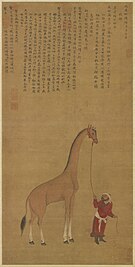
In the 16th century, Duarte Barbosa noted that many ships from the Kingdom of Cambaya in modern-day India sailed to Mogadishu with cloth and spices, for which they in return received gold, wax and ivory. Barbosa also highlighted the abundance of meat, wheat, barley, horses, and fruit on the coastal markets, which generated enormous wealth for the merchants.[86] Mogadishu, the center of a thriving textile industry known as toob benadir (specialized for the markets in Egypt, among other places[87]), together with Merca and Barawa, also served as a transit stop for Swahili merchants from Mombasa and Malindi and for the gold trade from Kilwa.[88] Jewish merchants from the Hormuz brought their Indian textile and fruit to the Somali coast in exchange for grain and wood.[89]
Trading relations were established with Malacca in the 15th century,[90] with cloth, ambergris and porcelain being the main commodities of the trade.[91] Giraffes, zebras and incense were exported to the Ming Empire of China, which established Somali merchants as leaders in the commerce between East Asia and the Horn.[92] Hindu merchants from Surat and Southeast African merchants from Pate, seeking to bypass both the Portuguese India blockade ( and later the Omani interference), used the Somali ports of Merca and Barawa (which were out of the two powers' direct jurisdiction) to conduct their trade in safety and without interference.[93]
Early modern era and the scramble for Africa

In the early modern period, successor states to the Adal Sultanate and Ajuran Sultanate began to flourish in Somalia. These included the Hiraab Imamate, the Isaaq Sultanate led by the Guled dynasty,[94][95] the Habr Yunis Sultanate led by the Ainanshe dynasty,[19] the Sultanate of the Geledi (Gobroon dynasty), the Majeerteen Sultanate (Migiurtinia), and the Sultanate of Hobyo (Obbia). They continued the tradition of castle-building and seaborne trade established by previous Somali empires.
Sultan Yusuf Mahamud Ibrahim, the third Sultan of the House of Gobroon, started the golden age of the Gobroon Dynasty. His army came out victorious during the Bardheere Jihad, which restored stability in the region and revitalized the East African ivory trade. He also had cordial relations and received gifts from the rulers of neighbouring and distant kingdoms such as the Omani, Witu and Yemeni Sultans.
Sultan Ibrahim's son Ahmed Yusuf succeeded him as one of the most important figures in 19th-century East Africa, receiving tribute from Omani governors and creating alliances with important Muslim families on the East African coast.
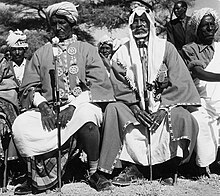
In Somalland, the Isaaq Sultanate was established in 1750. The Isaaq Sultanate was a Somali kingdom that ruled parts of the Horn of Africa during the 18th and 19th centuries.[94] It spanned the territories of the Isaaq clan, descendants of the Banu Hashim clan,[96] in modern-day Somaliland and Ethiopia. The sultanate was governed by the Rer Guled branch established by the first sultan, Sultan Guled Abdi, of the Eidagale clan.[97][98][99] According to oral tradition, prior to the Guled dynasty the Isaaq clan-family were ruled by a dynasty of the Tolje'lo branch starting from, descendants of Ahmed nicknamed Tol Je'lo, the eldest son of Sheikh Ishaaq's Harari wife. There were eight Tolje'lo rulers in total, starting with Boqor Harun (Somali: Boqor Haaruun) who ruled the Isaaq Sultanate for centuries starting from the 13th century.[100][101] The last Tolje'lo ruler Garad Dhuh Barar (Somali: Dhuux Baraar) was overthrown by a coalition of Isaaq clans. The once strong Tolje'lo clan were scattered and took refuge amongst the Habr Awal with whom they still mostly live.[102][103]
In the late 19th century, after the Berlin Conference of 1884, European powers began the Scramble for Africa. In that year, a British protectorate was declared over part of Somalia, on the African coast opposite South Yemen.[104] Initially, this region was under the control of the Indian Office, and so administered as part of the Indian Empire; in 1898 it was transferred to control by London.[104] In 1889, the protectorate and later colony of Italian Somalia was officially established by Italy through various treaties signed with a number of chiefs and sultans;[105] Sultan Yusuf Ali Kenadid first sent a request to Italy in late December 1888 to make his Sultanate of Hobyo an Italian protectorate before later signing a treaty in 1889.[106]

The Dervish movement successfully repulsed the British Empire four times and forced it to retreat to the coastal region.[107] The Darawiish defeated the Italian, British, Abyssinian colonial powers on numerous occasions, most notably, the 1903 victory at Cagaarweyne commanded by Suleiman Aden Galaydh,[108] forcing the British Empire to retreat to the coastal region in the late 1900s.[109] The Dervishes were finally defeated in 1920 by British airpower.[110]
The dawn of fascism in the early 1920s heralded a change of strategy for Italy, as the north-eastern sultanates were soon to be forced within the boundaries of La Grande Somalia ("Greater Somalia") according to the plan of Fascist Italy. With the arrival of Governor Cesare Maria De Vecchi on 15 December 1923, things began to change for that part of Somaliland known as Italian Somaliland. The last piece of land acquired by Italy in Somalia was Oltre Giuba, present-day Jubaland region, in 1925.[106]
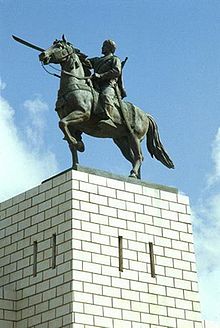
The Italians began local infrastructure projects, including the construction of hospitals, farms and schools.[111] Fascist Italy, under Benito Mussolini, attacked Abyssinia (Ethiopia) in 1935, with an aim to colonize it. The invasion was condemned by the League of Nations, but little was done to stop it or to liberate occupied Ethiopia. In 1936, Italian Somalia was integrated into Italian East Africa, alongside Eritrea and Ethiopia, as the Somalia Governorate. On 3 August 1940, Italian troops, including Somali colonial units, crossed from Ethiopia to invade British Somaliland, and by 14 August, succeeded in taking Berbera from the British.[citation needed]
A British force, including troops from several African countries, launched the campaign in January 1941 from Kenya to liberate British Somaliland and Italian-occupied Ethiopia and conquer Italian Somaliland. By February most of Italian Somaliland was captured and, in March, British Somaliland was retaken from the sea. The forces of the British Empire operating in Somaliland comprised the three divisions of South African, West African, and East African troops. They were assisted by Somali forces led by Abdulahi Hassan with Somalis of the Isaaq, Dhulbahante, and Warsangali clans prominently participating. The number of Italian Somalis began to decline after World War II, with fewer than 10,000 remaining in 1960.[112]
Independence (1960–1969)
Following World War II, Britain retained control of both British Somaliland and Italian Somaliland as protectorates. In 1945, during the Potsdam Conference, the United Nations granted Italy trusteeship of Italian Somaliland as the Trust Territory of Somaliland, on the condition first proposed by the Somali Youth League (SYL) and other nascent Somali political organizations, such as Hizbia Digil Mirifle Somali (HDMS) and the Somali National League (SNL)—that Somalia achieve independence within ten years.[113][114] British Somaliland remained a protectorate of Britain until 1960.[112]
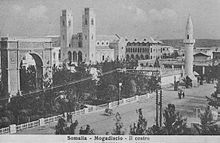
To the extent that Italy held the territory by UN mandate, the trusteeship provisions gave the Somalis the opportunity to gain experience in Western political education and self-government. These were advantages that British Somaliland, which was to be incorporated into the new Somali state, did not have. Although in the 1950s British colonial officials attempted, through various administrative development efforts, to make up for past neglect, the protectorate stagnated in political administrative development. The disparity between the two territories in economic development and political experience would later cause serious difficulties integrating the two parts.[115]

Meanwhile, in 1948, under pressure from their World War II allies and to the dismay of the Somalis,[116] the British returned the Haud (an important Somali grazing area that was presumably protected by British treaties with the Somalis in 1884 and 1886) and the Somali Region to Ethiopia, based on a treaty they signed in 1897 in which the British ceded Somali territory to the Ethiopian Emperor Menelik in exchange for his help against possible advances by the French.[117]
Britain included the conditional provision that the Somali residents would retain their autonomy, but Ethiopia immediately claimed sovereignty over the area. This prompted an unsuccessful bid by Britain in 1956 to buy back the Somali lands it had turned over.[113] Britain also granted administration of the almost exclusively Somali-inhabited Northern Frontier District (NFD) to Kenyan nationalists.[118][119] This was despite a plebiscite in which, according to a British colonial commission, almost all of the territory's ethnic Somalis favored joining the newly formed Somali Republic.[120]
A referendum was held in neighbouring Djibouti (then known as French Somaliland) in 1958, on the eve of Somalia's independence in 1960, to decide whether or not to join the Somali Republic or to remain with France. The referendum turned out in favour of a continued association with France, largely due to a combined yes vote by the sizable Afar ethnic group and resident Europeans.[121] There was also widespread vote rigging, with the French expelling thousands of Somalis before the referendum reached the polls.[122]
The majority of those who voted 'no' were Somalis who were strongly in favour of joining a united Somalia, as had been proposed by Mahmoud Harbi, Vice President of the Government Council. Harbi was killed in a plane crash two years later.[121] Djibouti finally gained independence from France in 1977, and Hassan Gouled Aptidon, a Somali who had campaigned for a 'yes' vote in the referendum of 1976, eventually became Djibouti's first president (1977–1999).[121]

On 1 July 1960, five days after the former British Somaliland protectorate obtained independence as the State of Somaliland, the territory united with the Trust Territory of Somaliland to form the Somali Republic,[123] albeit within boundaries drawn up by Italy and Britain.[124][125] A government was formed by Abdullahi Issa and Muhammad Haji Ibrahim Egal with other members of the trusteeship and protectorate governments, with Abdulcadir Muhammed Aden as President of the Somali National Assembly, Aden Abdullah Osman Daar as President of the Somali Republic, and Abdirashid Ali Shermarke as Prime Minister (later to become president from 1967 to 1969). On 20 July 1961 and through a popular referendum, was ratified popularly by the people of Somalia under Italian trusteeship, Most of the people from the former Somaliland Protectorate did not participate in the referendum, although only a small number of Somalilanders who participated the referendum voted against the new constitution,[126] which was first drafted in 1960.[24] In 1967, Muhammad Haji Ibrahim Egal became Prime Minister, a position to which he was appointed by Shermarke. Egal would later become the President of the autonomous Somaliland region in northwestern Somalia.
On 15 October 1969, while paying a visit to the northern town of Las Anod, Somalia's then President Abdirashid Ali Shermarke was shot dead by one of his own bodyguards. His assassination was quickly followed by a military coup d'état on 21 October 1969, in which the Somali Army seized power without encountering armed opposition — essentially a bloodless takeover. The putsch was spearheaded by Major General Mohamed Siad Barre, who at the time commanded the army.[127]
Somali Democratic Republic (1969–1991)

Alongside Barre, the Supreme Revolutionary Council (SRC) that assumed power after President Sharmarke's assassination was led by Brigadier General Mohamed Ainanshe Guled, Lieutenant Colonel Salaad Gabeyre Kediye and Chief of Police Jama Korshel. Kediye officially held the title "Father of the Revolution", and Barre shortly afterwards became the head of the SRC.[128] The SRC subsequently renamed the country the Somali Democratic Republic,[129][130] dissolved the parliament and the Supreme Court, and suspended the constitution.[131]
The revolutionary army established large-scale public works programs and successfully implemented an urban and rural literacy campaign, which helped dramatically increase the literacy rate. In addition to a nationalization program of industry and land, the new regime's foreign policy placed an emphasis on Somalia's traditional and religious links with the Arab world, eventually joining the Arab League in February, 1974.[132] That same year, Barre also served as chairman of the Organisation of African Unity (OAU), the predecessor of the African Union (AU).[133]
In July 1976, Barre's SRC disbanded itself and established in its place the Somali Revolutionary Socialist Party (SRSP), a one-party government based on scientific socialism and Islamic tenets. The SRSP was an attempt to reconcile the official state ideology with the official state religion by adapting Marxist precepts to local circumstances. Emphasis was placed on the Muslim principles of social progress, equality and justice, which the government argued formed the core of scientific socialism and its own accent on self-sufficiency, public participation and popular control, as well as direct ownership of the means of production. While the SRSP encouraged private investment on a limited scale, the administration's overall direction was essentially communist.[131]
In July 1977, the Ogaden War broke out after Barre's government used a plea for national unity to justify an aggressive incorporation of the predominantly Somali-inhabited Ogaden region of Ethiopia into a Pan-Somali Greater Somalia, along with the rich agricultural lands of south-eastern Ethiopia, infrastructure, and strategically important areas as far north as Djibouti.[134] In the first week of the conflict, Somali armed forces took southern and central Ogaden and for most of the war, the Somali army scored continuous victories on the Ethiopian army and followed them as far as Sidamo. By September 1977, Somalia controlled 90% of the Ogaden and captured strategic cities such as Jijiga and put heavy pressure on Dire Dawa, threatening the train route from the latter city to Djibouti. After the siege of Harar, a massive unprecedented Soviet intervention consisting of 20,000 Cuban forces and several thousand Soviet experts came to the aid of Ethiopia's communist Derg regime. By 1978, the Somali troops were ultimately pushed out of the Ogaden. This shift in support by the Soviet Union motivated the Barre government to seek allies elsewhere. It eventually settled on the Soviets' Cold War arch-rival, the United States, which had been courting the Somali government for some time. Somalia's initial friendship with the Soviet Union and later partnership with the United States enabled it to build the largest army in Africa.[135]
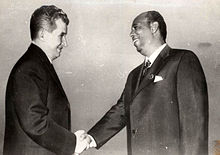
A new constitution was promulgated in 1979 under which elections for a People's Assembly were held. However, Barre's Somali Revolutionary Socialist Party politburo continued to rule.[130] In October 1980, the SRSP was disbanded, and the Supreme Revolutionary Council was re-established in its place.[131] By that time, Barre's government had become increasingly unpopular. Many Somalis had become disillusioned with life under military dictatorship.
The regime was weakened further in the 1980s as the Cold War drew to a close and Somalia's strategic importance was diminished. The government became increasingly authoritarian, and resistance movements, encouraged by Ethiopia, sprang up across the country, eventually leading to the Somali Civil War. Among the militia groups were the Somali Salvation Democratic Front (SSDF), United Somali Congress (USC), Somali National Movement (SNM) and the Somali Patriotic Movement (SPM), together with the non-violent political oppositions of the Somali Democratic Movement (SDM), the Somali Democratic Alliance (SDA) and the Somali Manifesto Group (SMG).
Somalia Civil War
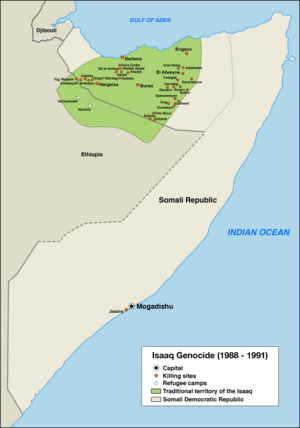
As the moral authority of Barre's government was gradually eroded, many Somalis became disillusioned with life under military rule. By the mid-1980s, resistance movements supported by Ethiopia's communist Derg administration had sprung up across the country. Barre responded by ordering punitive measures against those he perceived as locally supporting the guerrillas, especially in the northern regions. The clampdown included bombing of cities, with the northwestern administrative centre of Hargeisa, a Somali National Movement (SNM) stronghold, among the targeted areas in 1988.[136][137]
The clampdown initiated by Barre's government extended its reach beyond the initial bombings in the north to encompass various regions across the country. This reproduction of aggressive strategies aimed at stifling descent and retaining authority over the populace was a hallmark of the government's repressive actions in the South. One of the most notable instances occurred in 1991, when Barre's regime initiated a ruthless arial assault that led to the deaths of numerous innocent individuals in the town of Beledwene, situated in southern Somalia.[138] The cruelty and magnitude of this atrocity highlighted the degree to which the government was prepared to go to quash any sort of opposition or resistance, displaying a blatant disregard for human rights and the worth of human life.[139]
Another notable instance of Barre's repressive policies occurred in the city of Baidoa, which earned the nickname 'the city of death' due to the tragic events that unfolded there during the famine and civil war.[140] It is worth noting that hundreds of thousands of individuals lost their lives as a consequence of governmental strategies specifically aimed at the Rahanweyn community residing in these areas.[141]
During 1990, in the capital city of Mogadishu, the residents were prohibited from gathering publicly in groups greater than three or four. Fuel shortages, inflation, and currency devaluation impacted the economy. A thriving black market existed in the centre of the city as banks experienced shortages of local currency for exchange. Harsh exchange control regulations were introduced to prevent export of foreign currency. Although no travel restrictions were placed on foreigners, photographing many locations was banned. During daytime in Mogadishu, the appearance of any government military force was extremely rare. Alleged late-night operations by government authorities, however, included "disappearances" of individuals from their homes.[142]
In 1991, the Barre administration was ousted by a coalition of clan-based opposition groups, backed by Ethiopia's then-ruling Derg regime and Libya.[143] Following a meeting of the Somali National Movement and northern clans' elders, the northern former British portion of the country declared its independence as the Republic of Somaliland in May 1991. Although de facto independent and relatively stable compared to the tumultuous south, it has not been recognized by any foreign government.[144][145]
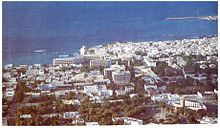
Many of the opposition groups subsequently began competing for influence in the power vacuum that followed the ouster of Barre's regime. In the south, armed factions led by USC commanders General Mohamed Farah Aidid and Ali Mahdi Mohamed, in particular, clashed as each sought to exert authority over the capital.[147] In 1991, a multi-phased international conference on Somalia was held in neighbouring Djibouti[148] Owing to the legitimacy bestowed on Muhammad by the Djibouti conference, he was subsequently recognized by the international community as the new President of Somalia.[148] He was not able to exert his authority beyond parts of the capital. Power was instead vied with other faction leaders in the southern half of Somalia and with autonomous sub-national entities in the north.[149] The Djibouti conference was followed by two abortive agreements for national reconciliation and disarmament, which were signed by 15 political stakeholders: an agreement to hold an Informal Preparatory Meeting on National Reconciliation, and the 1993 Addis Ababa Agreement made at the Conference on National Reconciliation.[citation needed]
In the early 1990s, due to the protracted lack of a permanent central authority, Somalia began to be characterized as a "failed state".[150][151][152]
Transitional institutions
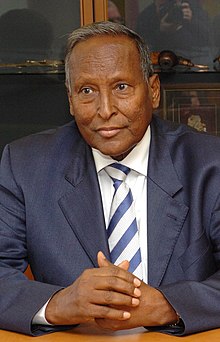
The Transitional National Government (TNG) was established in April–May 2000 at the Somalia National Peace Conference (SNPC) held in Arta, Djibouti. Abdiqasim Salad Hassan was selected as the President of the nation's new Transitional National Government (TNG), an interim administration formed to guide Somalia to its third permanent republican government.[153] The TNG's internal problems led to the replacement of the Prime Minister four times in three years, and the administrative body's reported bankruptcy in December 2003. Its mandate ended at the same time.[154]
On 10 October 2004, legislators elected Abdullahi Yusuf Ahmed as the first President of the Transitional Federal Government (TFG), the Transitional National Government's successor.[155] the TFG was the second interim administration aiming to restore national institutions to Somalia after the 1991 collapse of the Siad Barre regime and the ensuing civil war.[156]
The Transitional Federal Government (TFG) was the internationally recognised government of Somalia until 20 August 2012, when its tenure officially ended.[35] It was established as one of the Transitional Federal Institutions (TFIs) of government as defined in the Transitional Federal Charter (TFC) adopted in November 2004 by the Transitional Federal Parliament (TFP). The Transitional Federal Government officially comprised the executive branch of government, with the TFP serving as the legislative branch. The government was headed by the President of Somalia, to whom the cabinet reported through the Prime Minister. However, it was also used as a general term to refer to all three branches collectively.[citation needed]
Islamic Courts Union
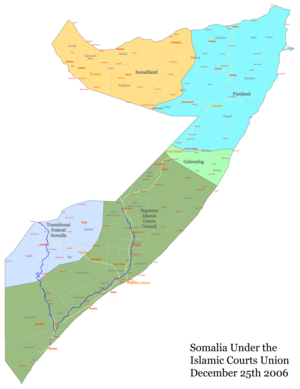
In 2006, the Islamic Courts Union (ICU), assumed control of much of the southern part of the country for 6 months and imposed Shari'a law. Top UN officials have referred to this brief period as a 'Golden era' in the history of Somali politics.[157][158]
Transitional Federal Government
The Transitional Federal Government sought to re-establish its authority, and, with the assistance of Ethiopian troops, African Union peacekeepers and air support by the United States, drove out the ICU and solidified its rule.[159] On 8 January 2007, TFG President Abdullahi Yusuf Ahmed entered Mogadishu with the Ethiopian military support for the first time since being elected to office. The government then relocated to Villa Somalia in the capital from its interim location in Baidoa. This marked the first time since the fall of the Siad Barre regime in 1991 that the federal government controlled most of the country.[160]
Al Shabaab insurgency
Al-Shabaab opposed the Ethiopian military's presence in Somalia and continued an insurgency against the TFG. Throughout 2007 and 2008, Al-Shabaab scored military victories, seizing control of key towns and ports in both central and southern Somalia. By January 2009, Al-Shabaab and other militias had forced the Ethiopian troops to retreat, leaving behind an under-equipped African Union peacekeeping force to assist the Transitional Federal Government's troops.[161]
Owing to a lack of funding and human resources, an arms embargo that made it difficult to re-establish a national security force, and general indifference on the part of the international community, Yusuf found himself obliged to deploy thousands of troops from Puntland to Mogadishu to sustain the battle against insurgent elements in the southern part of the country. Financial support for this effort was provided by the autonomous region's government. This left little revenue for Puntland's own security forces and civil service employees, leaving the territory vulnerable to piracy and terrorist attacks.[162][163]
On 29 December 2008, Yusuf announced before a united parliament in Baidoa his resignation as President of Somalia. In his speech, which was broadcast on national radio, Yusuf expressed regret at failing to end the country's seventeen-year conflict as his government had been mandated to do.[164] He also blamed the international community for their failure to support the government, and said that the speaker of parliament would succeed him in office per the Charter of the Transitional Federal Government.[165]
End of transitional period
Between 31 May and 9 June 2008, representatives of Somalia's federal government and the Alliance for the Re-liberation of Somalia (ARS) participated in peace talks in Djibouti brokered by the former United Nations Special Envoy to Somalia, Ahmedou Ould-Abdallah. The conference ended with a signed agreement calling for the withdrawal of Ethiopian troops in exchange for the cessation of armed confrontation. Parliament was subsequently expanded to 550 seats to accommodate ARS members, which then elected Sheikh Sharif Sheikh Ahmed, as president.[1]

With the help of a small team of African Union troops, the TFG began a counteroffensive in February 2009 to assume full control of the southern half of the country. To solidify its rule, the TFG formed an alliance with the Islamic Courts Union, other members of the Alliance for the Re-liberation of Somalia, and Ahlu Sunna Waljama'a, a moderate Sufi militia.[166] Furthermore, Al-Shabaab and Hizbul Islam, the two main Islamist groups in opposition, began to fight amongst themselves in mid-2009.[167] As a truce, in March 2009, the TFG announced that it would re-implement Shari'a as the nation's official judicial system.[168] However, conflict continued in the southern and central parts of the country. Within months, the TFG had gone from holding about 70% of south-central Somalia's conflict zones, to losing control of over 80% of the disputed territory to the Islamist insurgents.[160]
In October 2011, a coordinated operation, Operation Linda Nchi between the Somali and Kenyan militaries and multinational forces began against the Al-Shabaab in southern Somalia.[169][170] By September 2012, Somali, Kenyan, and Raskamboni forces had managed to capture Al-Shabaab's last major stronghold, the southern port of Kismayo.[171] In July 2012, three European Union operations were launched to engage with Somalia: EUTM Somalia, EU Naval Force Somalia Operation Atalanta off the Horn of Africa, and EUCAP Nestor.[172]

As part of the official "Roadmap for the End of Transition", a political process that provided clear benchmarks leading toward the formation of permanent democratic institutions in Somalia, the Transitional Federal Government's interim mandate ended on 20 August 2012.[28] The Federal Parliament of Somalia was concurrently inaugurated.[35]
Federal government
The Federal Government of Somalia, the first permanent central government in the country since the start of the civil war, was established in August 2012. In August 2014, the Somali government-led Operation Indian Ocean was launched against insurgent-held pockets in the countryside.[173]
Geography
Somalia is bordered by Ethiopia to the west, the Gulf of Aden to the north, the Somali Sea and Guardafui Channel to the east, and Kenya to the southwest. With a land area of 637,657 square kilometers, Somalia's terrain consists mainly of plateaus, plains and highlands.[174] Its coastline is more than 3,333 kilometers in length, the longest of mainland Africa.[12] It has been described as being roughly shaped "like a tilted number seven".[175]
In the far north, the rugged east–west ranges of the Ogo Mountains lie at varying distances from the Gulf of Aden coast. Hot conditions prevail year-round, along with periodic monsoon winds and irregular rainfall.[176] Geology suggests the presence of valuable mineral deposits. Somalia is separated from Seychelles by the Somali Sea and is separated from Socotra by the Guardafui Channel.
Administrative divisions
Somalia is officially divided into eighteen regions (gobollada, singular gobol),[1] which in turn are subdivided into districts. The regions are:
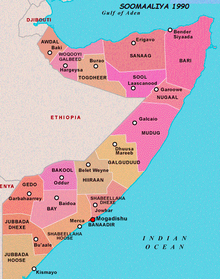
| Region | Area (km2) | Population[177][178] | Capital |
|---|---|---|---|
| Awdal | 21,374 | 1,010,566 | Borama |
| Bari | 70,088 | 949,693 | Bosaso |
| Nugal | 26,180 | 473,940 | Garowe |
| Mudug | 72,933 | 864,728 | Galkayo |
| Galguduud | 46,126 | 634,309 | Dusmareb |
| Hiran | 31,510 | 566,431 | Beledweyne |
| Middle Shabelle | 22,663 | 622,660 | Jowhar |
| Banaadir | 370 | 2,330,708 | Mogadishu |
| Lower Shabelle | 25,285 | 1,218,733 | Barawa |
| Togdheer | 38,663 | 962,439 | Burao |
| Bakool | 26,962 | 383,360 | Xuddur |
| Woqooyi Galbeed | 28,836 | 1,744,367 | Hargeisa |
| Bay | 35,156 | 1,035,904 | Baidoa |
| Gedo | 60,389 | 566,318 | Garbahaarreey |
| Middle Juba | 9,836 | 432,248 | Bu'aale |
| Lower Juba | 42,876 | 632,924 | Kismayo |
| Sanaag | 53,374 | 578,092 | Erigavo |
| Sool | 25,036 | 618,619 | Las Anod |
Northern Somalia is now de facto divided up among the autonomous regions of Puntland (which considers itself an autonomous state), Somaliland (a self-declared but unrecognized state) and newly established Khatumo State of Somalia. In central Somalia, Galmudug is another regional entity that emerged just south of Puntland. Jubaland in the far south is a fourth autonomous region within the federation.[1] In 2014, a new South West State was likewise established.[179] In April 2015, a formation conference was also launched for a new Hirshabelle State.[180]
The Federal Parliament is tasked with selecting the ultimate number and boundaries of the autonomous regional states (officially Federal Member States) within the Federal Republic of Somalia.[181][182]
Location

Somalia is bordered by Kenya to the southwest, the Gulf of Aden to the north, the Guardafui Channel and Indian Ocean to the east, and Ethiopia to the west. The country borders Djibouti. It lies between latitudes 2°S and 12°N, and longitudes 41° and 52°E. Strategically located at the mouth of the Bab el Mandeb gateway to the Red Sea and the Suez Canal, the country occupies the tip of a region that, due to its resemblance on the map to a rhinoceros' horn, is commonly referred to as the Horn of Africa.[1][183]
Waters
Zdroj:https://en.wikipedia.org?pojem=SomaliaText je dostupný za podmienok Creative Commons Attribution/Share-Alike License 3.0 Unported; prípadne za ďalších podmienok. Podrobnejšie informácie nájdete na stránke Podmienky použitia.
Antropológia
Aplikované vedy
Bibliometria
Dejiny vedy
Encyklopédie
Filozofia vedy
Forenzné vedy
Humanitné vedy
Knižničná veda
Kryogenika
Kryptológia
Kulturológia
Literárna veda
Medzidisciplinárne oblasti
Metódy kvantitatívnej analýzy
Metavedy
Metodika
Text je dostupný za podmienok Creative
Commons Attribution/Share-Alike License 3.0 Unported; prípadne za ďalších
podmienok.
Podrobnejšie informácie nájdete na stránke Podmienky
použitia.
www.astronomia.sk | www.biologia.sk | www.botanika.sk | www.dejiny.sk | www.economy.sk | www.elektrotechnika.sk | www.estetika.sk | www.farmakologia.sk | www.filozofia.sk | Fyzika | www.futurologia.sk | www.genetika.sk | www.chemia.sk | www.lingvistika.sk | www.politologia.sk | www.psychologia.sk | www.sexuologia.sk | www.sociologia.sk | www.veda.sk I www.zoologia.sk



